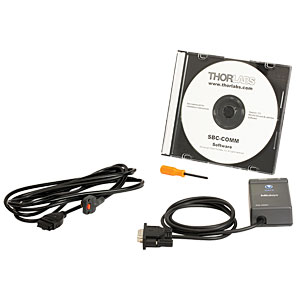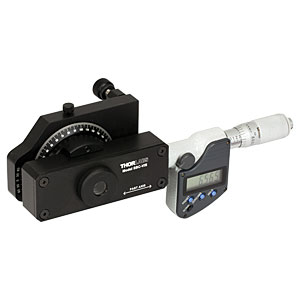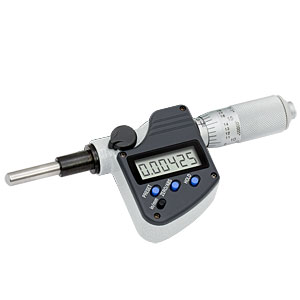Soleil-Babinet Compensators

- Continuously Variable Wave Plate with Uniform Retardance over Full Aperture
- Models for Visible or IR Spectral Ranges
- Graduated Rotation Ring
SBC-VIS
SBC-COMM

Please Wait

Click to Enlarge
Figure 1.1 SBC-IR Drawing
Features
- Uniform Retardance Over Full Aperture
- Continuously Variable Retardance from 0 to 2π
- Graduated Rotation Ring and Digital Micrometer Aid Repeatability
- 45° Detent Index Stops
- Options for 365 - 800 nm or 740 - 1650 nm
Applications
- Measurement of Unknown Retardances
- High-Resolution Ellipsometry
- Birefringence Compensation
The Soleil-Babinet Compensator is a continuously variable, zero-order retarder (wave plate) that operates over a broad wavelength range. The classical design of the compensator consists of a long birefringent wedge and a fixed wedge mounted to a compensator plate. The retardance is adjusted by moving the position of the long wedge relative to the short wedge using the included precision digital micrometer. This allows the retardance to vary continuously while maintaining a uniform retardance across the aperture at any given setting.
Crystalline quartz optics are used in both Soleil-Babinet Compensator models. The visible (SBC-VIS) and infrared (SBC-IR) models are designed for the 365 - 800 nm and 740 - 1650 nm spectral ranges, respectively.
Our standard Soleil-Babinet Compensators are uncoated for broad spectral operation. To minimize reflection losses when using the compensator over narrow wavelength ranges, we offer AR-coated versions upon request. Please contact Technical Support for more information on this option.
The optional SBC-COMM offers cables to provide an RS-232 interface to a PC. GUI software and LabVIEW VIs are provided to allow for easy calibration and readout of the retardance of the compensator. A CD with the software is included; the software may also be downloaded from the link on the Software tab.
The included digital micrometer has a Ø3/8" (Ø9.5 mm) mounting barrel and offers 1" (25.4 mm) of travel. To motorize an SBC, a Z925B DC servo motor can be used in place of the standard micrometer. Alternatively, Thorlabs' Liquid Crystal Variable Retarders may be a suitable alternative to a motorized SBC.
The Soleil-Babinet Compensator can be mounted on a post using one of the six #8 (M4) counterbores. These counterbores are arranged to allow for a vertical or horizontal orientation.
| Item # | SBC-VIS | SBC-IR |
|---|---|---|
| Wavelength Range | 365 - 800 nm | 740 - 1650 nm |
| Retardance Adjustment | 0 to 2π (Full Wave) | |
| Clear Aperture | Ø10 mm | |
| Beam Deviation | <1 arcmin | |
| Transmitted Wavefront Error | <λ/4 | |
| Surface Quality | 40-20 Scratch-Dig | |
| Digital Readout Resolution | 0.001 mm | |
| Repeatability Valuesa | @ 405 nm: 0.0016 waves @ 633 nm: 0.001 waves @ 800 nm: 0.0008 waves |
@ 1064 nm: 0.0012 waves @ 1550 nm: 0.0008 waves |
| Rotation | 360°, Continuous | |
| Rotation Division Scale | 1° Increments | |
| Detent Index Stops | Every 45° | |
| Mounting Holes | #8 (M4) Counterbore (6 Places) | |
Software for the SBC-COMM
Insights into Motion Control Using the DM713 Digital Micrometer
Scroll down to read about:
- Recording Position from Digital Micrometers
- DM713 Digital Micrometer: LabVIEW and C# Programming References
Click here for more insights into lab practices and equipment.
Recording Position from Digital Micrometers

Click to Enlarge
Figure 186B The SBC-COMM package shown here can be used to log data position data displayed by the DM713 digital micrometer.

Click to Enlarge
Figure 186A The DM713 digital micrometer (right) is included with and used to adjust the retardance provided by the
Digital micrometers, such as the DM713, are handy for moving a piece of optomech a specific distance. For example, a user might want to increment a translation stage holding a sample in front of an objective lens in order to focus the light to equally spaced points within the sample.
However, there are also times where the user might want to record the position of an event. One example could be making a distance measurement where the micrometer is set to a starting position, zeroed, and then translated the desired amount to display the distance.
Using the DM713 alone creates an extra step where the user has to read and record the display, which can be tedious in a dark lab where the display is not visible. One solution is to use Thorlabs' SBC-COMM, which includes an RS-232 interfacing cable. Thorlabs has created software application notes that walk the user through creating Visual C#® and LabVIEW® programs to continuously measure distances with the DM713. The application notes can be downloaded from links in the following section.
Another solution is to purchase the Mitutoyo® 05CZA662 SPC cable and IT-016U USB input tool that provide a push button and USB interfacing cable. With this device the user can open any text entry software package, press the single push button, and the device acts like a keyboard to enter the number into the software.
Date of Last Edit: Dec. 4, 2019
DM713 Digital Micrometer: LabVIEW and C# Programming References

Click to Enlarge
Figure 186C Visual C# and LabVIEW programs can be written to interrogate the DM713 Digital Micrometer. Examples are detailed in programming references available for download.
Programming references that provide introductions to communicating with the DM713 Digital Micrometer (Figure 186C) are available. One reference has been developed for LabVIEW, and the other for Visual C#. Each reference includes a step-by-step discussion for writing the program, as well as a section that concisely provide the full program text without explanation.
Included in the LabVIEW Programming Reference:
- Instructions for downloading and installing the driver software.
- Information concerning the required cabling and connecting to the DM713's COM port.
- Creation of a new VI that establishes serial communications with the DM713.
- Data from the DM713 is continuously received.
- The displacement value and its units of measurement are displayed.
- Logging a data value in response to a button click is implemented.
Included in the Visual C# Programming Reference:
- Information for connecting the computer to the DM713's COM port.
- Instructions for spawning a secondary thread to continuously communicate with the DM713.
- Procedure for operating on the received data, to extract the displacement value and units.
- Instructions for displaying the displacement values and units in the program's GUI.
- Logging a displacement value to a file in response to a button click.
Date of Last Edit: Dec. 4, 2019
| Posted Comments: | |
Silas Eul
(posted 2025-02-18 16:50:37.007) Hello,
what is the retardance accuracy/resolution of such a waveplate in the C-Band? cdolbashian
(posted 2025-02-26 03:47:36.0) Thank you for reaching out to us with this inquiry! This device is operated by finding the zero and 2pi phase shift for a users' light source, and then allowing continuous control of the phase via the micrometer attached to the sliding wedge of the crystal within the compensator itself. As such, we do not really have a resolution, per say, as it will be determined by the total travel distance of the crystal wedge, in order to find the 0 and 2pi phase shift, as well as the resolution of the micrometer used to move the wedge itself (0.001mm). Levin Seidt
(posted 2025-02-11 11:04:23.78) Hello Thorlabs, I want to use the Soleil-Babinet SBC-VIS compensator and was wondering about the absolute optical thickness of the component. I will use it in one beam arm and need to know this to find the temporal overlap of both beams again quickly. I will operate around 680nm. Can you give me any insight on that? This would be great. I really appreciate any help you can provide. cdolbashian
(posted 2025-02-20 09:24:06.0) Thank you for reaching out to us with this inquiry Levin! I have contacted you directly to discuss the range of phase shifts which you could expect to see when you use this device with your 680nm laser. user
(posted 2024-12-06 09:41:10.18) Hello, I have been using the SBC product, and I have noticed that during my experiment, when continuously collecting the phase of the spectrum, the phase suddenly changes even though I did not adjust the SBC. I have ruled out other possibilities, and the only remaining factor is the SBC. I now suspect that there might be an issue with the SBC. Do you have staff in the China region? I would like to arrange for the SBC to be repaired. Thank you. EGies
(posted 2024-12-18 04:47:17.0) Thank you for contacting Thorlabs. I have reached out to you directly regarding further troubleshooting steps. Our support email for Thorlabs China is techsupport-cn@thorlabs.com. Benjamin Pohl
(posted 2023-11-10 12:28:56.623) I am interested in a compensator without mechanical moving parts, e.g. based on a pockels cell. Is there a reason you don't have such a device?
Best regards
Benjamin Pohl cdolbashian
(posted 2023-12-15 09:36:07.0) Thank you for reaching out to us with this inquiry! We do indeed have some active electro-optical phase/polarization controllers. I have contacted you regarding our liquid-crystal and EO modulator products and their potential usage for your application. Vladimir Zenin
(posted 2021-04-12 09:05:11.48) I am wondering why the wavelength range is still limited to either VIS or NIR range? I can guess that the crystals in VIS are not thick enough, so they are not providing half-wave retardance for longer wavelengths. But what is a problem in operating SBC-IR in the visible range? Also, what are problems or limitations for longer wavelengths >1650 nm? cdolbashian
(posted 2021-04-15 11:07:00.0) Thank you for contacting ThorLabs. The Soleil-Babinet compensator is a phase retarder that uses a variable thickness birefringent material to control the retardance of the light passing through it. By changing the thickness of the material, a user can change the retardance such that they can achieve >1 full wave of retardation within the specified wavelength range. We split these devices in to two separate components to allow sufficient resolution for each range. One can indeed operate the NIR (longer wavelength) version with a visible (shorter wavelength) light source, but the full translation of the micrometer is tuned to induce > 1 full wave retardation of the longest wavelength of the NIR range. In this case, you will have effectively ~1/2 the resolution for a wave in the visible range, as the same translation of the crystal will change the phase difference by 2x as much. On the other hand, the visible compensator can also be used for longer wavelengths, but it will not necessarily be able to create the same range of phase shifts for the larger wavelengths, as it is designed for >1 wave in the visible (shorter wavelength) ranges . This same idea holds true for using the NIR compensator for wavelengths >1650nm, you will likely be able to get diminishing retardation as you move away from 1650, but the farther you go, you will be able to retard fractionally less of the wave. nettony
(posted 2017-12-12 22:15:19.477) Dear person in charge
I just got SBC-IR, and it doesn't work for "45 Dentent Stops".
The manual says, 'see Appendix C', but I cannot find such Appendix section from my manual and that from this website. nbayconich
(posted 2017-12-19 08:48:47.0) Thank you for contacting Thorlabs. The SBC has knob on the top that can loosen the detent spring tension. I will reach out to you directly to help troubleshoot your problem. We have corrected the manual that has no references to the non-existent appendix. evan.meyer.scott
(posted 2017-03-07 14:24:01.117) I would like to know the transmission of the SBC-IR at 1550 nm please, not just the reflectance of the AR coatings. tfrisch
(posted 2017-03-13 06:45:04.0) Hello, thank you for contacting Thorlabs. Our stock compensators are uncoated so that they can be used over the whole defined wavelength range, so with 6 uncoated surfaces, the transmission would be roughly 78%. It looks like you are already in contact with our Technical Support Team about a quote for a coated version. user
(posted 2016-03-17 10:36:38.58) What kind of mount to you need for the SBC? besembeson
(posted 2016-03-17 12:12:46.0) Response from Bweh at Thorlabs USA: There are counter bore holes by the kinematic mount for #8 or M4 cap screws to connect the unit to our TR series post and post holders: http://www.thorlabs.us/newgrouppage9.cfm?objectgroup_id=1266 and http://www.thorlabs.us/newgrouppage9.cfm?objectgroup_ID=1268 user
(posted 2014-04-10 17:01:48.82) Has the person who designed this ever heard anything about the laws of the lever?
Works in principle, but the mechanical periphery is highly awkward! besembeson
(posted 2014-04-10 01:37:53.0) Response from Bweh E at Thorlabs:Hello, Thanks for contacting Thorlabs. I believe you are alluding to the actuator that sticks out of the SB Compensator? I can see your concern but we have tested this arrangement and we found that it doesn't affect the performance of the unit. If you think this is suitable for your application and you would like to probably get a loan unit to test this or you want an alternate actuator, please contact techsupport@thorlabs.com and we will gladly assist you regarding this. Adam
(posted 2010-04-07 12:16:22.0) A response from Adam at Thorlabs to dgtlc: The crystals inside the SBC-VIS are not AR coated. We currently have not considered adding a VIS-NIR version to our catalog. I will recommend this to our engineering team as a customer inspired idea. Theoretically, the SBC-VIS should be useable up to 1064nm. At 800nm, the retardance is > 1.75 waves, so at 1064nm, the retardance will be > 1.3 waves. I will contact you directly with more information about the product. apalmentieri
(posted 2010-03-02 16:48:39.0) A response from Adam at Thorlabs to a.bruni: I would like to get more information about your setup and how you intend to use the CCD camera. I will email you directly to get this information. a.bruni
(posted 2010-03-02 13:56:31.0) Dear,
I am Eng. Bruni from Loccioni Group, I would like to have some information about your babinet compesator. I have to performed a polariscope using CCD Camera and light sorce, please send me same information if it is possible to use this compesator with a CCD camera.
All the best
Andrea klee
(posted 2009-11-03 10:02:35.0) A response from Ken at Thorlabs to teng3123: The optics in the SBC-VIS and SBC-IR are not anti-reflection coated. However, we can make them with AR coating as specials. Please let us know if you would like to have a quotation. teng3123
(posted 2009-11-03 02:48:37.0) Was the crystal inside the SBC-VIS anti-reflection coated? About 30% of the laser power was lost after passed through SBC-VIS. |
 Products Home
Products Home









 Soleil-Babinet Compensator
Soleil-Babinet Compensator